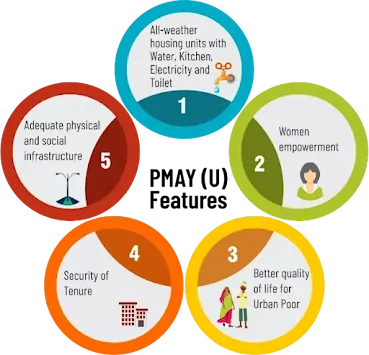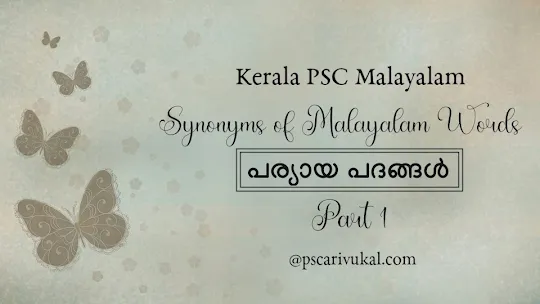The Pradhan Mantri Awas Yojana (PMAY), meaning "Prime Minister's Housing Scheme," is a flagship initiative of the Government of India launched with the ambitious goal of providing affordable housing for all citizens by the year 2022.
Recognizing the fundamental need for shelter and its role in socio-economic development, PMAY aims to address the housing shortage in the country's urban and rural areas.
It operates through two distinct components:
- Pradhan Mantri Awas Yojana - Urban (PMAY-U): Focuses on addressing the housing needs of the urban poor and middle-income groups.
- Pradhan Mantri Awas Yojana – Gramin (PMAY-G): Previously known as the Indira Awas Yojana (IAY), this component targets affordable housing for the rural poor.
While the initial target year was 2022, the schemes have been extended and operate with revised targets and strategies.
Table of Contents
Basic Facts
- Launched on:
- PMAY-U: June 25, 2015
- PMAY-G: November 20, 2016 (restructured from IAY)
- Ministry Responsible:
- PMAY-U: Ministry of Housing and Urban Affairs (MoHUA)
- PMAY-G: Ministry of Rural Development (MoRD)
- Objective: To provide "Housing for All" by a specific timeframe (initially 2022, now extended with revised targets).
- Scope: Nationwide, covering both urban and rural regions.
- Approach: A multi-pronged approach involving beneficiary-led construction, credit-linked subsidies, affordable housing in partnership, and slum redevelopment.
Target Group:
The PMAY targets specific socio-economic groups based on income levels:
- Economically Weaker Section (EWS): Annual household income up to ₹3 lakh.
- Low-Income Group (LIG): Households with an annual income between ₹3 lakh and ₹6 lakh.
- Middle-Income Group (MIG) I: Annual household income between ₹6 lakh and ₹12 lakh (primarily under PMAY-U's Credit Linked Subsidy Scheme in its initial phase).
- Middle-Income Group (MIG) II: Households with an annual income between ₹12 lakh and ₹18 lakh (primarily under PMAY-U's Credit Linked Subsidy Scheme in its initial phase).
- Rural Poor: Identified based on housing deprivation parameters and socio-economic and caste census (SECC) data under PMAY-G. Priority is given to households without shelter, living in dilapidated houses, and specific vulnerable groups.
Key Features of PMAY
- Financial Assistance: Providing financial support to eligible beneficiaries for constructing, purchasing, or upgrading their homes. The nature and quantum of assistance vary based on the scheme component and income category.
- Credit-Linked Subsidy Scheme (CLSS): Offers interest subsidies on home loans for EWS, LIG, and initially MIG beneficiaries (under PMAY-U).
- Beneficiary-Led Construction (BLC): Empowers eligible beneficiaries to construct their own houses with financial assistance from the government.
- Affordable Housing in Partnership (AHP): Encourages the development of affordable housing projects by the public and private sectors through financial assistance per EWS house constructed.
- In-Situ Slum Redevelopment (ISSR): Focuses on redeveloping existing slums with the participation of slum dwellers, providing houses to eligible families.
- Technology Innovation: Promoting the use of modern, innovative, and green construction technologies to ensure quality, speed, and sustainability.
- Preference to Vulnerable Groups: Giving preference to women (ownership or co-ownership), Scheduled Castes/Tribes, Other Backward Classes, minorities, persons with disabilities, and senior citizens.
- Community Participation: Encouraging the involvement of local communities in the planning and implementation process (especially in PMAY-G).
- Convergence with Other Schemes: Synergizing with other government schemes like Swachh Bharat Mission, Ujjwala Yojana, and Saubhagya Yojana to provide basic amenities to households.
- Direct Benefit Transfer (DBT): Ensuring that financial assistance is directly transferred to the beneficiaries' bank accounts for transparency and efficiency.
Pradhan Mantri Awas Yojana - Urban 2.0 (PMAY-U 2.0)
PMAY-U 2.0 is the extended and improved phase of the original PMAY-U scheme, launched on September 1, 2024.
It builds upon lessons learnt from the PMAY-U and aims to overcome past implementation challenges while enhancing overall impact.
The core objective -- "Housing for All" in urban India -- remains unchanged. The revised target is to assist 1 crore urban families over the next five years (2024–2029).
Key Features and Enhancements of PMAY-U 2.0
- Continued Focus on Target Groups: Maintaining the focus on EWS, LIG, and now explicitly emphasizing the housing needs of the urban poor and middle-class families.
- Refined Financial Assistance Mechanisms: Maintains core strategies like ISSR, BLC, AHP, and Affordable Rental Housing Complexes (ARHC), with possible adjustments in quantum or eligibility.
- Emphasis on Sustainability and Climate Resilience: Increased focus on promoting eco-friendly and disaster-resilient construction technologies through incentives and guidelines.
- Affordable Rental Housing Complexes (ARHC): A significant focus on creating affordable rental housing for urban migrants and the working poor, utilizing vacant government-funded houses and constructing new units.
- Integration with Urban Planning: Aligns housing with broader city planning, including transit-oriented development and infrastructure integration.
- Technology Adoption: Promotes the adoption of advanced construction methods to improve efficiency and reduce costs.
- Preference to Specific Vulnerable Groups: Reinforces preferences for women, SC/ST/OBCs, minorities, persons with disabilities, senior citizens, transgenders, and slum dwellers.
- Streamlined Processes: Aiming for more efficient and transparent processes for beneficiary identification, application, and fund disbursement.
- Focus on Completing Existing Projects: Strong push to complete homes sanctioned in the earlier PMAY-U phase, alongside new approvals.
As of now, the Pradhan Mantri Awas Yojana has sanctioned over 118.64 lakh houses, out of which over 2.67 lakh houses are specifically for women, encompassing single women and widows.
Additionally, the scheme has extended its reach to marginalized communities, with approximately 80,000 houses sanctioned for Scheduled Castes, 15,000 for Scheduled Tribes, and 90 for transgender individuals.
Association with the Union Budget 2025
The Union Budget 2025–26, presented on February 1, 2025, plays a pivotal role in shaping and supporting PMAY-U 2.0 and allocated ₹19,794 crore for the PMAY-U scheme.
It serves as the financial and policy backbone of the scheme in the following ways:
Financial Allocation
- Allocates resources to meet the five-year goal of assisting 1 crore families.
- Reflects government plans to extend assistance to an additional 3 crore households (as previously announced).
- Likely features a sustained or enhanced funding level for the Ministry of Housing and Urban Affairs.
Policy Directives and Incentives
- May revive or expand CLSS (Credit Linked Subsidy Scheme) benefits, especially for MIG categories.
- Potential tax incentives for buyers of affordable housing under PMAY-U 2.0.
- Development incentives for private builders collaborating on affordable housing projects.
- Specific support for ARHC (Affordable Rental Housing Complexes) development.
- Possible increase in Technology Innovation Grants (TIG) to promote sustainable construction.
- Budget provisions for essential urban infrastructure (water, sanitation, roads, connectivity) that complement housing goals.
- Synergies with initiatives like Smart Cities Mission and Urban Challenge Fund boost overall urban transformation.
Support to Financial Institutions
- Measures to enhance the lending capacity of housing finance institutions to ensure smooth credit flow to beneficiaries.
- Likely includes frameworks to track progress, ensure transparency, and assess the scheme’s socio-economic impact.
In essence, PMAY-U 2.0, backed by the Union Budget 2025–26, aims to translate the vision of Housing for All into a more sustainable, inclusive, and resilient reality for India’s urban population.
With a refined approach, robust financial support, and a strong emphasis on inclusion and innovation, the scheme is poised to play a transformative role in India’s urban development over the coming years.
Also read:
Thanks for reading!!!











Post a Comment
Post a Comment